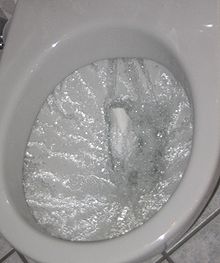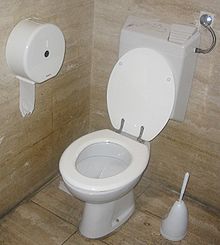toilet flush
A toilet flush is the device in water closets that ensures that the bowl is flushed with water at the desired time, which carries urine , excrement and toilet paper into the sewer system .
The previously usual flush volume of 9 liters can often be reduced to less than 6 liters in modern toilet bowls. The volume for partial flushes is typically 3 to 4 liters.
In areas with drinking water scarcity , the toilet is preferably flushed with well , rain , gray or other service water instead of tap water .
history
The Englishman John Harington built a water flush on behalf of Queen Elisabeth I as early as 1596 , but it was not until 1775 that Alexander Cumming , who is considered the inventor of the modern toilet, received attention .
Flushing systems
Essentially, a distinction is made between two flushing systems, the pressure washer and the box washer . The vacuum flushing is a special form, mainly in marine toilets comes from transport to application.
Flush valve
A water pipe with a larger nominal diameter is required to operate a pressure flushing device in order to achieve a sufficiently large volume flow. It is triggered by pressing a lever that releases a servo valve. Shutting down is hydraulically time-delayed and gentle in order to avoid damage to the water installation from water hammer. This design was common until the early 1970s. Noise development can be a disadvantage if the pipeline has not been soundproofed. If the main line is insufficiently dimensioned, the line pressure can also drop when the flush is actuated. Since flush valves are more robust than the mostly free-hanging cisterns, they are still used today for wall-mounted installations in public toilets.
Cistern washer
In both private and public areas, the box washer is the more common variant today. There is a cistern above the toilet bowl. The cistern is filled with five to ten liters of water via a float valve within a few minutes.
The water collected in the cistern is released after the flush has been triggered and pours through the flush pipe with a nominal width of usually 32 to 40 mm into the toilet bowl.
A distinction is made between surface-mounted cisterns that are visible above the toilet bowl and concealed (flush-mounted) cisterns that are either walled in (wet construction) or covered by a light pre-wall (dry construction). The pre-wall technology reduces effort and costs.
For some time , cisterns have often been equipped with a thin layer of styrofoam on the inside to reduce flow noise and condensation on the outside of the cistern.
The flow pressure of the flush water results from the height difference between the cistern and the toilet bowl. In the past, the cistern in the toilet room was installed above head height in order to increase the flow and the flushing effect above the drop height. Suspended cisterns were operated by pulling a cord, rod or chain. With the rod it was possible to end the flushing process early.
Washdown cisterns have a larger flush pipe diameter. Since the water level of the flushing water is usually only half a meter above the bowl, the flushing flow would otherwise be too low. It is triggered by pressing a button or plate or by pulling a knob. The latter variant allows the flushing process to be canceled. Button-operated devices sometimes have a second button or a switch mechanism to interrupt the flushing process.
Modern cisterns usually empty completely after actuation. This is achieved by a float designed drain plug, which is also known as a siphon bell . To trigger the flushing process, the drain plug is raised. Due to the water flowing under the closure, the pressure there is now the same as above. Since the closure is no longer pressed onto the seal seat by the water pressure, the floating body gives the siphon bell buoyancy until the water has flowed out of the box.
For reasons of drinking water hygiene, the possibly germ-contaminated cistern contents must be prevented from being sucked back into the drinking water pipe. This can happen if, for example, when the main line in the basement is emptied, a vacuum occurs in the connection line due to the siphon effect . The backflow is prevented by filling the cistern in the free outlet. By positioning the filling valve above the highest water level, no water can be sucked back.
At 44 liters per person per day, private households use more drinking water for flushing toilets than for any other purpose. In order to reduce drinking water consumption, cisterns are equipped with dual flush technology or a flush stop function. With the two-volume flush technology, only about three liters of water are used for the small flush. Depending on the cistern, up to six liters are then available for rinsing. A full flush uses four to nine liters, depending on the cistern and setting.
Occasionally, sewage companies complain that the lower average water consumption leads to inadequate flushing of the sewer system .



Triggering the flush
Manual flush
In private households, the flushing systems are usually triggered manually by pressing a button or pulling a chain. Special electronic and pneumatic release devices are also suitable for disabled people. Pneumatic flush actuation enables remote actuation by transmitting the actuation force via an air hose between the control button and the actuation mechanism.
Automatic flushing
Automatic flush systems are common in public buildings and inns. They are particularly hygienic as no control elements are required to be touched and the flushing takes place reliably after each use.
Sensor-controlled systems
In urinals and Pinkel gutters one is often photocell used at urinals and toilets is z. B. used a reflex light switch . There are also urinals in which a heat sensor responds to urine at body temperature and triggers flushing.
In systems with a radar sensor , centimeter waves are sent out by the transmitter, the reflections of which are changed by the approaching user, which is detected by the receiving sensor . The sensor can be installed invisibly under the tiles.
With the conductive principle, the change in the conductivity of the liquid in the siphon is recorded, which results from the increase in the salt content when urinating. Alternatively, the pH value can be measured in the siphon.
Capacitive systems measure the approach of a person with a special capacitive sensor .
Timed flush
In the case of urinals and pee channels in public facilities, time-controlled flushing is also carried out at a fixed interval. With frequent use, this can save rinse water.
See also
Web links
Individual evidence
- ↑ cisterns , in: Ryter-Hermann.de
- ↑ Netzeitung: Daily 44 liters of water in the toilet ( Memento from September 27, 2013 in the Internet Archive )
- ↑ Bayerischer Rundfunk Alexander Dallmus: Saving water: Is saving water nonsensical in Germany? March 21, 2018 ( br.de [accessed May 10, 2020]).
- ↑ https://patentscope.wipo.int/search/en/detail.jsf?docId=WO2008017314 Patent capacitive sensor for urinals




